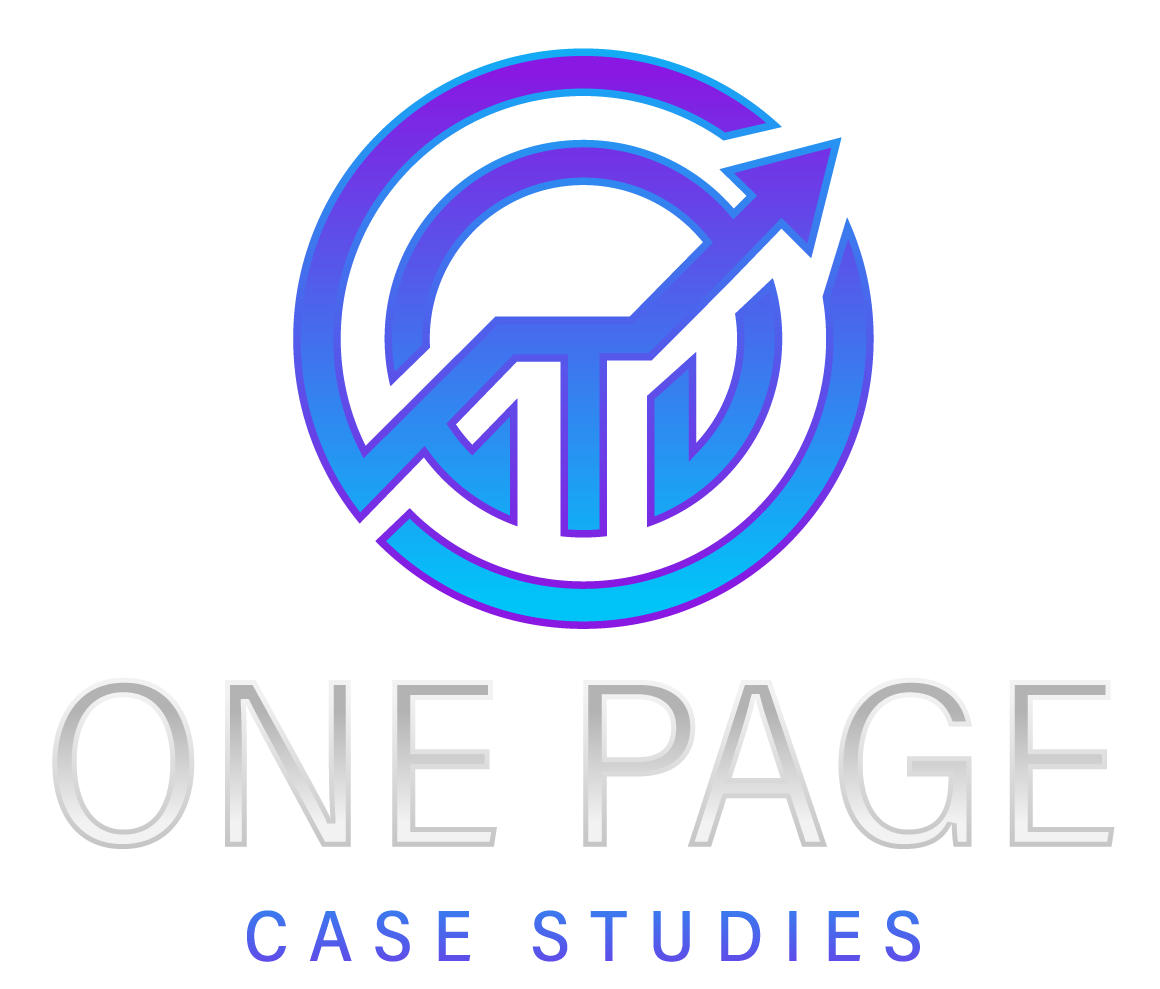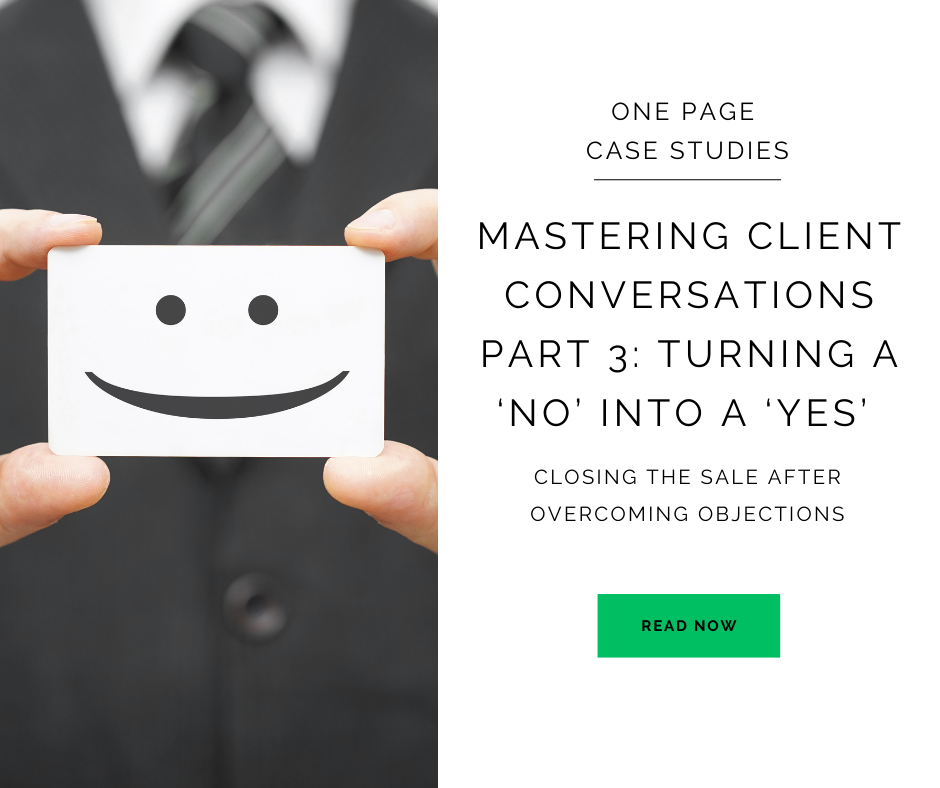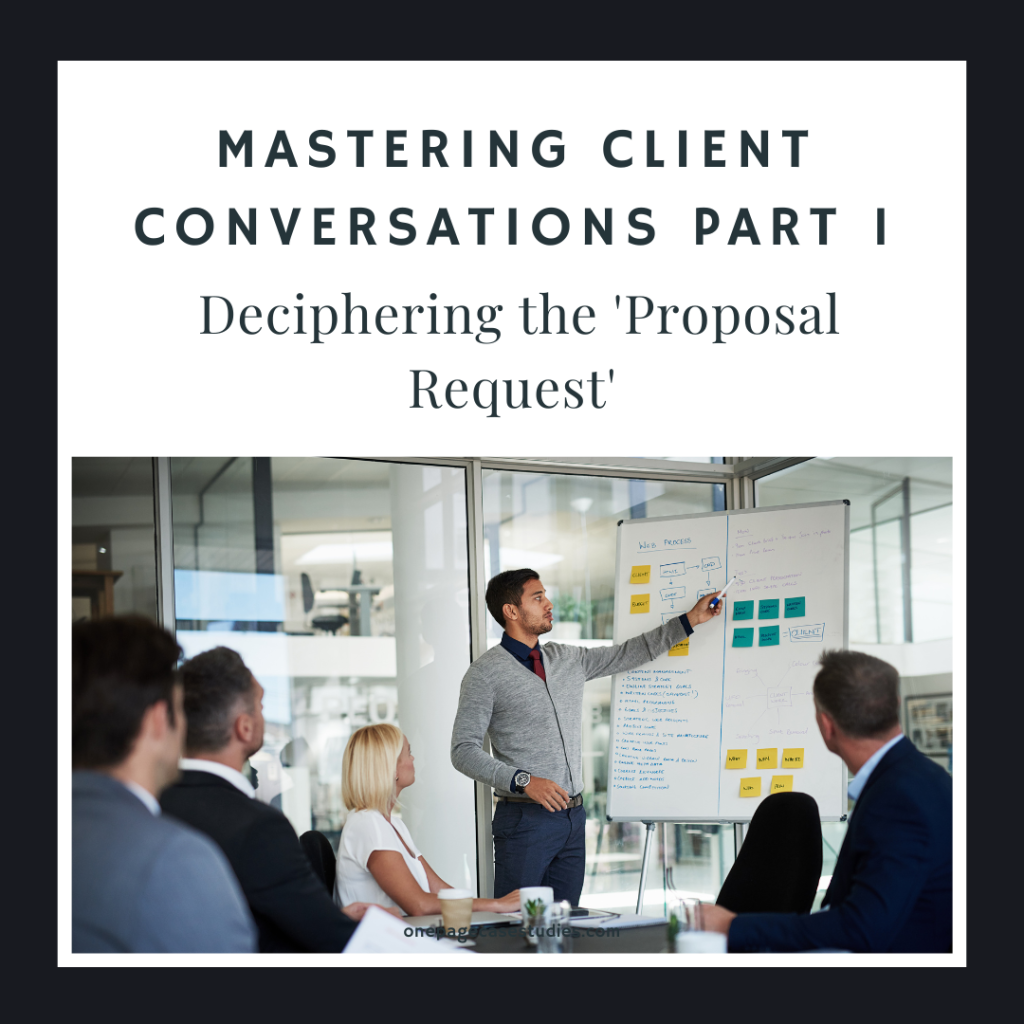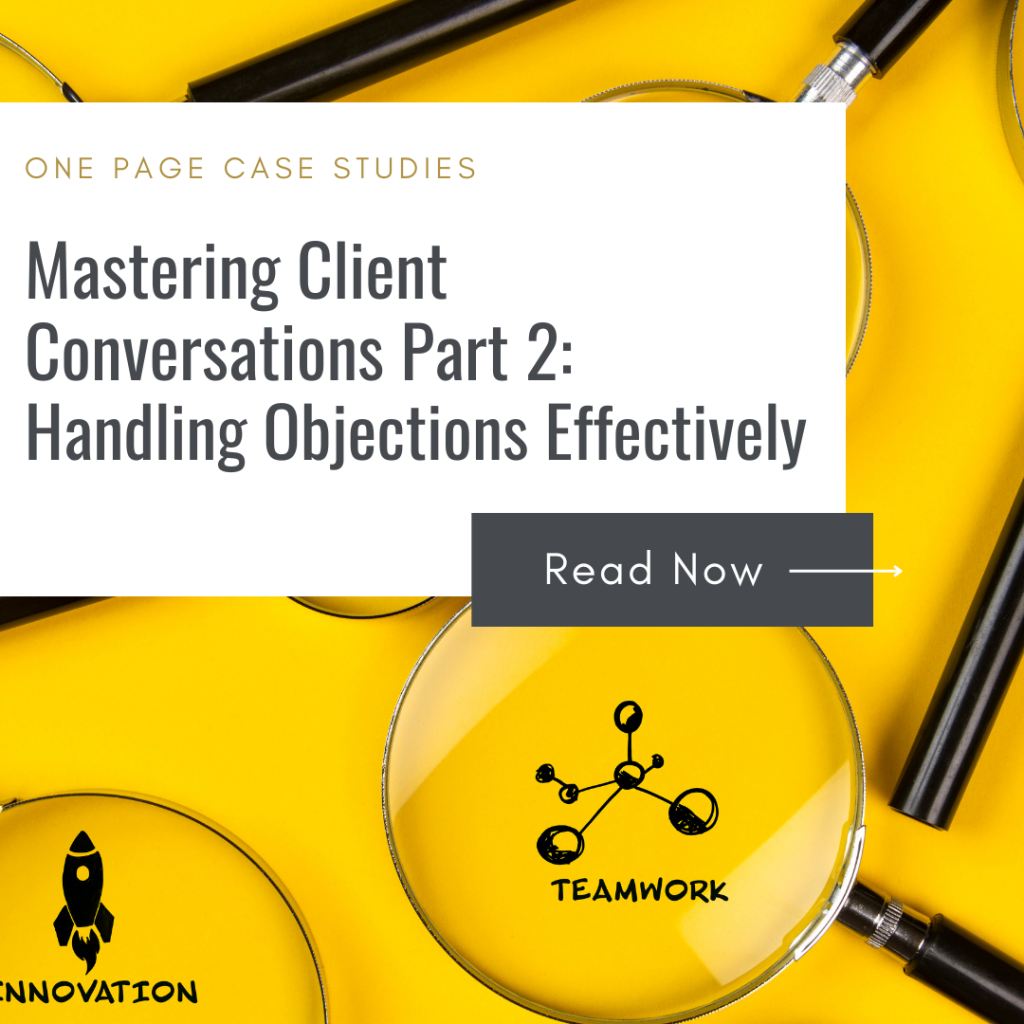Navigating the landscape of sales involves understanding the prospect’s concerns, finding effective ways to address them, and finally, turning their ‘no’ into a ‘yes’. In this final part of our “Mastering Client Conversations: From Hesitation to Affirmation” series, we explore effective sales closing technique after overcoming objections. If you’re yet to explore the previous posts in this series, we strongly recommend you catch up here Mastering Client Conversations Part 1: Deciphering the ‘Proposal Request’ and
Mastering Client Conversations Part 2: Handling Objections Effectively.
Now, let’s move forward and unravel the mysteries of turning rejections into approvals, solidifying your prowess in sales conversations
Setting the Stage for ‘Yes’
After overcoming the client’s objections, it’s time to transition towards closing the sale. This stage involves several key strategies:
- Strategic Recap: Don’t just revisit the solutions you’ve provided. Instead, highlight the unique value your services can bring to their specific situation. Construct a narrative that directly links their challenges to your solutions.
- Creating a Conducive Atmosphere: The client’s comfort and feeling of being understood are essential at this stage. The conversation should foster trust, respect, and positivity.
- Client Empowerment: Subtly remind the clients that they are in control. Reinforce that your ultimate aim is to serve their best interests, not just to close the sale.
- Aligning with Client Goals: Always tie your solutions back to the client’s original objectives and goals. This alignment reaffirms that you’ve understood their needs and tailored your offerings accordingly.
- Enthusiasm and Confidence: Display genuine enthusiasm for your solution and confidence in its effectiveness. This energy can be infectious and build the client’s confidence in moving forward.
- Addressing Last-Minute Concerns: Even at this stage, clients might have lingering doubts or new questions. Be prepared to address these patiently, ensuring that the client feels heard and reassured.
- Trial Closes: Use trial closing techniques to gauge the client’s readiness to commit. Questions like “How does this solution sound to you so far?” can reveal if the client is ready to proceed or needs more information.
Remember, the goal at this stage is not just to secure a ‘yes’, but to make the client feel confident and excited about their decision.

Top 6 Key Techniques to Close the Sale
In the previous posts, we’ve explored understanding client hesitations and addressing objections effectively. Now, as we approach the pivotal stage of closing the sale, we’ll delve into the Top 6 Key Techniques to Close the Sale that can make all the difference in turning a promising conversation into a successful partnership.
The art of closing the sale involves finesse, adaptability, and a deep understanding of your client’s needs and desires. Each technique we’ll discuss below plays a crucial role in creating a conducive environment for a positive response.
1. Summary Close
The summary close is a powerful way to reiterate the value your services provide. By summarizing the entire conversation, you emphasize how your solutions align with the client’s unique needs and objectives. Highlighting key discussion points and showcasing how your offerings address their concerns reinforce the value you bring to the table. For example:
Step 1: Recap Solutions: Before utilizing the Summary Close, briefly recap the solutions and benefits you’ve discussed earlier in the conversation. This serves as a reminder of the value you offer.
Step 2: Emphasize Unique Value: Emphasize how your services meet the client’s unique needs and objectives. Highlight key discussion points and showcase how your offerings address their concerns.
What to Say to the Client:
“We’ve discussed how our customized SEO strategy can increase your website’s visibility and drive more organic traffic, leading to increased sales. Does that align with your goals?”
2. Now-or-Never Close
Creating a sense of urgency can be a compelling motivator for prospects. The now-or-never close involves offering a special incentive or limited-time offer that’s only available if they choose to close the deal now. However, it’s vital to strike a balance between urgency and respect for their decision-making process to avoid sounding pushy.
Step 1: Present Exclusive Incentive: Offer a special incentive or limited-time offer that’s only available if they choose to close the deal now. This creates a sense of urgency without being pushy.
Step 2: Balancing Urgency and Respect: Strike a balance between urgency and respect for their decision-making process. Avoid sounding overly insistent, ensuring they feel comfortable with their choice.
What to Say to the Client:
Client: “I’m interested in your digital marketing services, but I’m still considering a few other agencies.”
Now-or-Never Close: “I understand you have a few options to consider, and I want to make sure you get the best value. To help you with your decision, I can offer you an exclusive 15% discount on our services, but this offer is only available if you decide to proceed within the next 48 hours. This will give you the opportunity to experience the results firsthand and see the impact of our strategies on your business.”
In this example, the Now-or-Never Close creates a sense of urgency by offering a time-sensitive discount. By doing so, the client is more likely to make a decision sooner, knowing they have an exclusive incentive to act quickly. However, it’s essential to balance the urgency with respect for their decision-making process to avoid sounding overly pushy or insincere.

3. Question Close
This technique involves using strategic questions to nudge the client towards a close by encouraging them to envision the positive outcomes of working with you. By asking the right questions, you prompt them to consider the benefits and advantages of moving forward. Here’s how to execute the Question Close effectively:
Step 1: Recap Solutions: As with the other techniques, start by briefly recapping the solutions and benefits discussed earlier in the conversation.
Step 2: Identify Their Goals: Ask strategic questions that prompt the client to envision how your services align with their business objectives.
Step 3: Highlight Success Stories: Share success stories or case studies of how your services have helped previous clients achieve their goals. This provides real-world examples of the positive outcomes they could experience by partnering with you.
Step 4: Encourage Decision-Making: After asking these questions and providing examples, gently guide them towards the decision-making process.
What to Say to the Client (3 examples):
“Given the potential for increased sales and brand authority, how do you feel about moving forward with our digital marketing services?”
“Considering the impact on your website’s visibility and organic traffic, do you think our SEO strategy is the right fit for your business?”
“If we were to begin our services next week, how would that align with your current business objectives?”
By using the Question Close, you prompt the client to think critically about the benefits they stand to gain from your services, leading them to a more confident and informed decision.
4. The Assumptive Close
Confidence is key in the assumptive close. Here, you proceed as if the sale will happen and guide the conversation accordingly. For example:
Step 1: Gauge Positive Response: Before employing the Assumptive Close, ensure the client has expressed positive interest in your proposal.
Step 2: Assume the Sale: Proceed confidently, assuming that the client is ready to proceed. Guide the conversation as if the decision has already been made.
What to Say to the Client:
Client: I’m really impressed with your proposal and the solutions you’ve presented.
Assumptive Close: “Thank you for your kind words! I’m thrilled that you’re impressed with our proposal. Let’s move forward with the plan we discussed, and I’ll send over the contract for you to review. Once you’ve had a chance to look it over, we can schedule a kickoff meeting to get started on implementing the strategies for your business. Sound good?”
In the Assumptive Close, you assume that the client is ready to proceed and smoothly transition into the next steps without explicitly asking for their decision. By confidently assuming the sale and offering to send the contract for review, you create a natural flow in the conversation, making it easier for the client to move forward.
However, it’s essential to gauge the client’s response and be prepared to address any concerns or questions they may have. The goal is to be confident in your approach while remaining attentive to their needs throughout the process.

5. The Choice Close
Empowering the client with a choice can be a highly effective technique. Offer two favorable options, both leading to a positive outcome, and allow them to decide which aligns better with their business needs. This approach makes them feel in control of the decision-making process and increases their engagement in the final choice. Here’s how you can implement the Choice Close effectively:
Step 1: Present the Options: Clearly present two favorable options to the client. Ensure that both options align with their goals and provide significant value.
Step 2: Highlight Benefits: Emphasize the benefits and advantages of each option. Showcase how each choice meets specific needs and objectives.
Step 3: Empower Decision-Making: Encourage the client to make their decision, expressing the positive outcomes they can expect, regardless of which option they choose.
What to Say to the Client (2 examples):
“Based on our discussions, you have two fantastic options. Option A offers [benefits], while Option B provides [benefits]. Take your time to consider which one aligns better with your current business objectives.”
“Both packages offer significant value to your business, and either choice will lead to increased brand visibility and customer engagement. Take your time to consider which package aligns best with your current objectives.”
By giving the client a choice, you empower them to take an active role in the decision-making process and help them feel confident in their final decision.
6. The Fear of Missing Out (FOMO) Close
Leveraging the fear of missing out on a valuable opportunity can be a persuasive technique. Highlight the potential benefits they would miss out on if they don’t seize the opportunity to work with you. For example:
Step 1: Exclusive Offers: Offer exclusive incentives or limited-time offers that are only available if they choose to proceed with your services within a specific timeframe.
Step 2: Showcase Success Stories: Share success stories or case studies of previous clients who benefited from similar offers.
Step 3: Create Urgency: Emphasize the time-sensitive nature of the offer and the benefits they stand to gain by acting promptly.
What to Say to the Client:
“By partnering with us now, you can take advantage of our exclusive early-bird discount, only available this week.”
The FOMO Close taps into the client’s sense of urgency, making them more likely to take action sooner rather than later. However, always ensure that the urgency is genuine and that the offer truly provides value to the client.
These key techniques are valuable tools in your arsenal for closing the sale. Remember, the goal is to create an environment where the client feels comfortable, understood, and confident in saying ‘yes.’ By employing these methods strategically, you can navigate the final stage of the sales conversation with finesse and achieve successful outcomes for both your clients and your business.

The Role of Follow-Up in Turning ‘No’ into ‘Yes’
Turning a “no” into a “yes” doesn’t always happen instantly. In many cases, it requires strategic follow-up and continued engagement with the client. Here’s how to approach the follow-up process effectively:
- Respectful Persistence: When you receive a “no” from a client, it’s essential to respect their decision while also being persistent in your follow-up efforts. Avoid being pushy or aggressive, as it can alienate the client. Instead, express your understanding of their decision and leave the door open for future communication.
- Reinforce Value: In your follow-up interactions, reinforce the value of your services and the benefits the client can gain from working with you. Share additional success stories or testimonials to remind them of the positive outcomes achieved by others who chose to partner with your business.
- Address Concerns: If the client expressed specific concerns or objections during the initial conversation, use the follow-up as an opportunity to address those points. Provide more information or clarify any misunderstandings to alleviate their worries.
- Timing is Key: Be mindful of the timing of your follow-up messages. Give the client some space after their initial decision, but don’t wait too long to re-engage. Finding the right balance will vary from case to case, so trust your intuition and adapt accordingly.
- Offer New Insights: Use the follow-up as an opportunity to provide the client with new insights or updates related to their business needs. For example, you could share recent industry developments, innovative solutions, or relevant success stories that align with their goals.
- Show Genuine Interest: Express genuine interest in the client’s success and demonstrate that you value the potential partnership. When following up, show that you are attentive to their needs and enthusiastic about finding the best solutions for their business.
- Personalization and Customization: Tailor your follow-up messages to each client’s specific situation. Personalization shows that you’ve taken the time to understand their business and unique challenges, making the conversation more meaningful and relevant.
By employing these strategies in your follow-up communications, you maintain a positive relationship with the client, keep the lines of communication open, and increase the chances of turning a “no” into a “yes.” Remember, the key is to show genuine interest in their success and respect their decision-making process.
Learning from ‘No’
Receiving a “no” from a potential client is not the end of the conversation; it’s an opportunity to learn and improve. Embrace the “no” as a chance to gain valuable insights that can refine your approach and foster growth in your business. Here’s how to turn a “no” into a learning experience:
- Reflect and Analyze: Take the time to reflect on the client interaction and analyze the reasons behind their decision. Were there any specific concerns or objections they raised? Understanding their perspective can help you identify areas for improvement.
- Seek Feedback: If appropriate, kindly ask the client for feedback on your proposal or sales approach. Constructive feedback provides valuable information that can lead to valuable improvements in your future interactions.
- Fine-tune Your Strategy: Use the insights gained from the “no” to fine-tune your sales strategy. Whether it’s adjusting your pitch, refining your value proposition, or addressing common objections in advance, continuous improvement is key to success.
- Stay Positive and Professional: A gracious and professional response to a “no” leaves a lasting impression on the client. Maintaining a positive attitude demonstrates your professionalism and genuine interest in their needs, even if they haven’t chosen to move forward at this time.
- Nurture the Relationship: Just because a client said “no” now doesn’t mean they won’t be interested in the future. Keep the lines of communication open and nurture the relationship. Send occasional updates, relevant content, or personalized messages to stay connected without being intrusive.
- Stay Agile and Adaptable: The business landscape is dynamic, and client needs may evolve over time. Stay agile and be prepared to adapt your offerings to align with changing market demands and client requirements.
- Celebrate Small Wins: Celebrate your small wins along the way, even if the final sale hasn’t been made. Building a successful business involves a series of positive interactions, client relationships, and incremental progress.

Remember, each “no” is an opportunity to grow, improve, and strengthen your approach. Stay resilient and persistent, and use each experience as a stepping stone to future success. By learning from every “no,” you enhance your ability to secure more “yes” responses in the future.
Congratulations! You’ve now reached the end of our “Mastering Client Conversations: From Hesitation to Affirmation” series. We’ve explored the crucial stages of understanding client reservations, addressing objections, and ultimately closing the sale. Throughout this journey, you’ve gained valuable insights and techniques to navigate the intricate landscape of sales conversations.
Recap of Key Sales Closing Techniques:
- Understanding the Proposal Request: When a client asks for a proposal, it’s essential to recognize that it may not be the actual request. Take the time to dig deeper, understand their underlying needs, and tailor your response accordingly.
- Addressing Objections Effectively: Articulate your solutions to their concerns with empathy and understanding. Proactively address potential objections and offer case studies or success stories to build confidence in your services.
- Turning a ‘No’ into a ‘Yes’: The closing stage involves finesse and adaptability. Utilize key sales closing techniques like the Summary Close, Now-or-Never Close, Question Close, Assumptive Close, Choice Close, and Fear-of-Missing-Out (FOMO) Close to guide the client towards a positive decision.
- The Role of Follow-Up: Follow-up is crucial in building and maintaining relationships with potential clients. Respectfully persist with periodic check-ins, offering further assistance without being pushy.
- Learning from ‘No’: Embrace “no” responses as learning opportunities. Seek feedback, refine your approach, nurture relationships, and stay agile in adapting to changing client needs.
As you apply these sales closing techniques and continuously refine your approach, you’ll enhance your ability to connect with clients, understand their needs, and secure more successful outcomes. By mastering these sales closing techniques, you can confidently navigate the intricate landscape of client conversations and achieve impressive results in your sales efforts.
Now that you’ve learned these valuable sales closing techniques, put them into practice! Engage in real-world client conversations and apply the art of understanding, addressing objections, and closing the sale. Remember, each interaction is a chance for growth and improvement.
Thank You
We hope you’ve found this series insightful and valuable for your professional journey. If you have any questions, share your experiences, or need further guidance, feel free to comment below. Your feedback is essential to us as we continue to create content tailored to your needs.
Keep Learning and Growing
The journey of mastering client conversations is one of continuous learning and adaptation. Stay curious, continue to explore new strategies, and keep growing both personally and professionally. Your dedication to refining your skills will undoubtedly lead to greater success in your business.
Stay Connected
For more valuable content and updates, join our community of like-minded professionals by joining our Facebook group or following our social media channels. We look forward to staying connected and supporting your journey.
Remember, mastering the art of conversation is a skill that evolves with practice and dedication. Your commitment to honing these skills will set you apart in the competitive landscape of client engagement. Keep striving for excellence, and success will follow. 🚀



